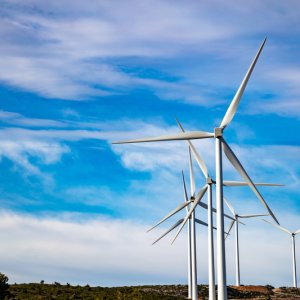
What Lies Ahead for Mexico’s Utility-Scale Wind Development?
 By Cas Biekmann | Journalist and Industry Analyst -
Wed, 07/07/2021 - 14:02
By Cas Biekmann | Journalist and Industry Analyst -
Wed, 07/07/2021 - 14:02
Wind energy was long at the forefront of Mexico’s clean energy transition. Already being one of the earliest renewable technologies boosted by the pre-2014 Energy Reform’s Self Supply schemes, the reform strengthened wind energy’s position in the mix. But with a new government, a different attitude arose, slowing down new wind energy development to a grinding halt. Regardless of the short-term challenges, MBN industry experts think wind energy’s long-term potential remains attractive.
Data from the Mexican Wind Energy Association (AMDEE) shows that Mexico currently has 68 wind parks in operation, providing 7,154MW of capacity. This means that around 8.6 percent of Mexico’s energy mix is generated through wind turbines. Fourteen states already benefit from this resource, although Oaxaca is the state with the largest installed wind capacity by far, at 2,749MW. Tamaulipas is second with 1,715MW, followed by Nuevo Leon’s 793MW. With US$13 billion in investment, Mexico’s wind projects represent a sizeable chunk of both national and foreign direct investment.
New Project Development Still on the Way
AMDEE shows that as of March 2021, 300MW of wind energy were going through pre-operational testing stages and 400MW were still in various stages of construction. In April, Italian renewable energy developer Enel Green Power reported that its 274MW Dolores wind farm, located in Nuevo Leon’s China municipality, have officially entered commercial operation on April 26. The US$290 million renewable energy project had been won during Mexico’s long-term energy auctions, establishing a 20-year PPA with grid operator CENACE. EDF Renewables’ 252MW Gunaa Sicarú wind farm, also originating at the auctions, is currently under construction. “Before the pandemic, the Ministry of Energy (SENER) reinitiated the public consultation process in two Oaxacan municipalities. Before launching the second phase, the pandemic forced a halt to this process and it has not yet restarted. We hope to see the process restart in June 2021,” explained Gerardo Pérez, Vice President and Country Manager Mexico of EDF Renewables.
Auctions are not the only driver for wind energy development. Mexican mining giant Grupo Mexico invested US$250 million in the Fenicias Energy Center to add 168MW of renewable capacity to the company’s growing clean energy portfolio. “The objective is to bring the wind farm into operation this year. We believe this goal is achievable even within the current environment marked by slowdowns,” said David Fatzinger, Vice President and Country Manager Mexico of Invenergy.
Pipelines Run Dry – For Now
After this wave of projects, however, industry insiders warn that there is a lack of new developments. “Greenfield projects pretty much stopped. In 2021, we are still benefiting from the wave of new capacity planned years ago,” explained Federico Muciño, Founder and Consulting Partner at Epscon. At the heart of this stop in development lies the break with previous policy brought by the López Obrador administration. After the current president entered office in 2018, he vowed to rescue CFE, opting to work to again place the state utility at the forefront of the energy sector. Following years of liberation driven by private companies attracted to the market, investment began to decline. Without the rock-solid confidence needed to construct multi-million-dollar projects for a long-term operation, renewable energy companies found themselves in a difficult position. Data from AMDEE shows that investment in the energy sector will drop by 61 percent in 2021. In 2020, the wind sector expected approximately US$1.3 billion dollars in investments, but in 2021 investment will barely reach US$500 million.
SENER’s energy sector development plan PRODEN shows that by to 2024, 14.8 percent of newly installed energy capacity should be wind energy. Out of the 13,677MW of total new capacity, wind energy’s share would amount to around 2,024MW. But if no new greenfield developments are uninitiated, wind energy might come to a standstill after the current projects become operational. After all, if investment opportunities open again, it will take several years before such projects enter operation.
For solar developers, distributed generation offers an interesting avenue worth exploring, despite smaller margins and more specialized applications. But behind-the-meter wind solutions are unfortunately not viable in the current environment. Therefore, companies in the wind sector often opt to slow down their developments as much as possible, knowing that in the future wind energy might experience a boom once again. “We have close to 3,000MW of projects, but in light of the regulatory situation in Mexico’s energy sector, our development has gone into slow motion. We are doing the minimum amount of work necessary to ensure that we do not lose the progress that we have already achieved,” said Pérez about EDF’s renewable developments.
For now, companies are waiting to see how the situation develops, according to Pérez. “First, we need to see how the rules in the energy sector pan out. For example, our power generation is being curtailed and the government is attempting to change the LIE or even the constitution if this fails. More than anything, this introduces uncertainty regarding what might come. Nevertheless, our investors are not leaving the Mexican market or reducing operations.”
New Technologies, New Perspectives
Once the outlook shifts, companies looking to develop new wind energy will have new tools at the ready to further push down the levelized cost of energy (LCOE), to deal with intermittency and to boost the sustainability of the power plant’s lifecycle. Battery storage could be an important addition toward load shifting for wind energy projects, helping it to produce energy in a stable manner if the wind drops, for instance. In general, wind energy technology has greatly improved in the past decade, dropping costs while increasing efficiency. “We believe that in recent years, there has been an important revolution in the sector. With new technology, we have been able to optimize operations and maintenance of our equipment,” said Enric Català, Senior Sales Director for Latin America at Vestas, during Mexico Energy Forum. Vestas, along with the Circular Economy for Thermosets Epoxy Composites (CETEC) coalition, also stands at the forefront of a new solution that could greatly help the sustainability of wind energy projects. Now, old turbine blades are piling up in landfills. However, in a few years their materials can be broken down so they can be recycled. When Mexico’s wind energy sector eventually does reactivate, it could do so boasting a heretofore unseen low LCOE, with an added sustainability boost.
















